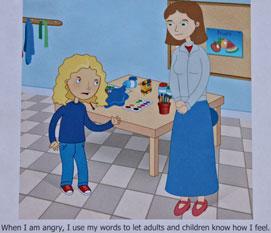What it is
An area of student need, involving difficulty with using appropriate behaviours for a given situation.
Teaching Strategies

Instructional
• Determine a baseline of current level of self-regulation (Antecedent, Behaviour and Consequence (ABC) chart/frequency chart).
• Determine the function and triggers of behaviours.
• Develop and implement alternative programming goals on the student’s Individual Education Plan (IEP).
• Directly teach self-regulation methods for calming and pausing before acting to make a better choice.
• Positively reinforce appropriate behaviour and/or use of self-regulation strategies – use formalized chart/tracking to do this.
• Re-direct the student at the onset of behaviours or when triggers are present.
• Reduce/remove triggers.
• Use daily home communication.
• Encourage use of a computer and/or assistive technology.
• Teach and use calming strategies.
• Role play/re-enact situations.
• Model the use of positive behaviours.
• Use visual cues to show the steps of pro-social behaviours.
• Give advance warning of changes to the schedule and of staff.
• Use social stories.
• Teach specific social skills.
• Allow for frequent breaks (physical walk or activity).
• Regularly review classroom rules and consequences.
• Consistently apply rules and consequences.
• Calmly re-direct behaviours.
• Label and acknowledge the choices that the student makes.
Less...
More...

Environmental
• Use preferential seating to position the student close to the teacher for prompts and near assistive technology.
• Reduce visual and auditory distractions.
• Provide stress reduction aids (stress ball, doodling paper, iPod).
• Post a visual schedule.
• Use a visual timer.
• Post classroom rules and consequences.

Assessment
• Provide an alternative setting for tests.
• Allow extra time.
• Allow breaks during testing.
• Use oral testing/scribing.
• Use computers/assistive technology.
• Give advance notice of tests.
• Allow for reference materials to be used during testing.
• Provide a choice of assignments.
• Control selection of students for group projects (teacher chooses groups).
• Chunk assignments into parts and give feedback at each step.
Resources







